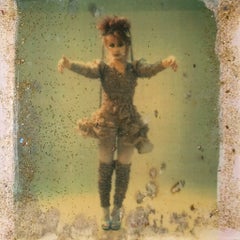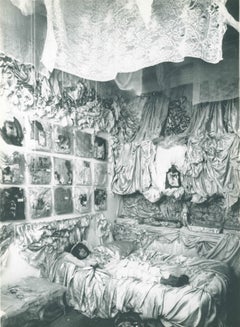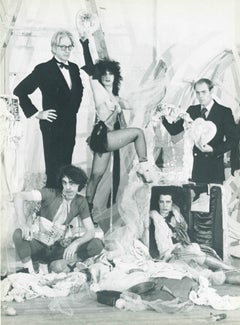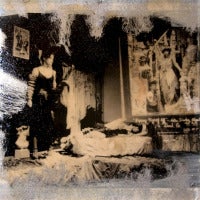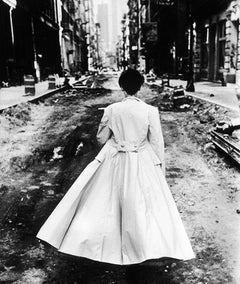Colette Lumiere Art
to
10
6
4
10
Overall Height
to
Overall Width
to
10
9
7
4
3
3
3
3
2
2
2
1
1
1
1
1
1
1
9
1
8
1
10
6,996
3,377
2,513
1,212
3
1
1
Artist: Colette Lumiere
Let Them Eat Cake (Marie Antoinette au Petit Trianon)
By Colette Lumiere
Located in New York, NY
Rare photolithograph by Colette.
Category
21st Century and Contemporary Colette Lumiere Art
Materials
Lithograph
Beautiful Dreamer - Uniform Series
By Colette Lumiere
Located in New York, NY
Colette Lumiere, better known as Colette is a multimedia artist known for her pioneering work in performance art, street art and the constructed photograph. She is also known for her...
Category
1970s 85 New Wave Colette Lumiere Art
Materials
Mixed Media
Clearance Sale
By Colette Lumiere
Located in New York, NY
Rare photolithograph by Colette.
Category
1970s Colette Lumiere Art
Materials
Lithograph
Justine and the Victorian Punks
By Colette Lumiere
Located in New York, NY
Complete set of 4 available for $1000
Category
1970s Colette Lumiere Art
Materials
Lithograph
"Ragdoll"... Rizzioli's "Fashion as Fantasy"
By Colette Lumiere
Located in New York, NY
Complete set of 4 available for $1000
Category
1970s Colette Lumiere Art
Materials
Offset
Fashion Show for Fiorucci Line at Mudd Club
By Colette Lumiere
Located in New York, NY
Colette Lumiere, better known as Colette is a multimedia artist known for her pioneering work in performance art, street art and the constructed photograph. She is also known for her...
Category
1970s Colette Lumiere Art
I'm not Blond and I'm Not Dumb
By Colette Lumiere
Located in New York, NY
Colette Lumiere, better known as Colette is a multimedia artist known for her pioneering work in performance art, street art and the constructed photograph. She is also known for her...
Category
1970s Colette Lumiere Art
The Living Environment, Earth Angel
By Colette Lumiere
Located in New York, NY
Colette Lumiere, better known as Colette is a multimedia artist known for her pioneering work in performance art, street art and the constructed photograph. She is also known for her...
Category
1970s Colette Lumiere Art
Deadly Feminine
By Colette Lumiere
Located in New York, NY
Colette Lumiere, better known as Colette is a multimedia artist known for her pioneering work in performance art, street art and the constructed photograph. She is also known for her...
Category
1980s Colette Lumiere Art
Justine at Banco Gallery
By Colette Lumiere
Located in New York, NY
Colette Lumiere, better known as Colette is a multimedia artist known for her pioneering work in performance art, street art and the constructed photograph. She is also known for her...
Category
1970s Colette Lumiere Art
Related Items
'Evening Dress' Limited Edition silver gelatin V&A Portfolio
By John French
Located in London, GB
'Evening Dress' Limited Edition V&A Portfolio
silver gelatin fibre print.
Jean Shrimpton modelling a dress, John French (1907-66), England, 1961
© Victoria and Albert Museum, London...
Category
1950s Modern Colette Lumiere Art
Materials
Silver Gelatin
Free Shipping
H 30 in W 30 in
Mercer Street, 1992
By Todd Burris
Located in Hudson, NY
Listing is for UNFRAMED print. Inquire within for framing.
Edition of 1 of 10
If the exhibition piece is sold or the customer orders a different print size, the photograph is produced upon purchase. Please allow two weeks for production.
Shipping time depends on method of shipping.
Price is subject to availability. The Robin Rice Gallery reserves the right to adjust this price depending on the current edition of the photograph
This exhibition is a visual dance of contradictions. Whimsical and sophisticated. Stylistic and simple. Studied and carefree. That’s what emerges when you take a photojournalist by study, fashion photographer by trade and fine artist by instinct and leave him alone with his camera and a muse. Burris’ work is influenced by his early career spent working with fashion photographer Bill King and inspired by the decisive moment made known by the Henri Cartier Bresson. He defies the confines of either discipline. It is not fashion photography, which is by nature produced, but rather purely spontaneous.
Todd left the world of fashion photography after building his own career in Milan and New York to go to LA and find his niche. He embraced his fascination with flea markets and penchant for discarded items that wouldn’t ever be chosen because they were trendy but because they were interesting. Burris packed his 1979 white Pontiac station wagon with his finds. When he came upon a stage that fit the props, he called on his muses and created a visual story on the spur of a moment.
The collection of black and white images conveys a sense of effervescence and Élan. It includes photographs from Burris' time in Los Angeles as well as earlier experimental work in Milan and New York City.
Anything but superficial, the invitational image, "Paget #1" challenges the traditional symmetry of beauty. We see a dramatic close up of a woman’s face, her intense eyes framed by the stark contrast between her porcelain skin and jet black hair. The lighting is such that her face is divided by shadow, one half dark and mysterious, the other half light and classically beautiful. The effect is deeply engaging. The viewer doesn’t know when the photo was taken but you want to know more.
In “Mercer Street...
Category
21st Century and Contemporary Contemporary Colette Lumiere Art
Materials
Silver Gelatin
'Soft Helmets' V&A Portfolio Limited Edition print
By John French
Located in London, GB
'Soft Helmets' V&A Portfolio Limited Edition print
Pattie Boyd and Celia Hammond modelling feathered capsule hats, John French (1907-66), London, 1960s
© Victoria and Albert M...
Category
1960s Modern Colette Lumiere Art
Materials
Silver Gelatin
Keith Haring, Party of Life Invitation, 1986 (Framed)
By Keith Haring
Located in Manchester, GB
Keith Haring, Party of Life Invitation, 1986 (Framed)
102 x 102cm
Giclée print on matt 250gsm conservation digital paper made in Germany from acid and chlorine free wood pulp. Manu...
Category
1990s Contemporary Colette Lumiere Art
Materials
Lithograph
Stieglitz, O'Keeffe Hands w/Thimble, Alfred Stieglitz Memorial Portfolio (after)
By Alfred Stieglitz
Located in Auburn Hills, MI
Halftone photographic print on gloss photographic paper. Unsigned and unnumbered, as issued. Good Condition; never framed or matted. Notes: From the folio, Alfred Stieglitz Memorial Portfolio 1864-1946, 1947. Published by Twice a Year Press, New York; printed by Lakeside Press, Chicago, 1947. Excepted from the folio, edition limited to fifteen-hundred copies. INTRODUCTORY NOTE-AMERICA WITHOUT ALFRED STIEGLITZ, Twice during his life, and now again after his death, the compelling and magnetic personality of Alfred Stieglitz has evoked spontaneous group tribute. In America and Alfred Stieglitz, as in the earlier and memorable No. 47 of Camera Work, the elusive question: What is the meaning of Stieglitz? was posed. In both volumes—as in so much other writing about him-it was answered in as many ways as there were artists, writers, composers-individuals in all fields of endeavor attempting to "explain" him. Indeed, the meaning and influence of Stieglitz as artist, patron, teacher, inspirer, friend, critic, were so vastly complex, it may be that no single estimate of him could at any point fully cover all facets of his character. Thus it may be both inevitable and particularly fitting that a memorial volume to him should also be in the form of a group tribute the more so since he himself so firmly believed that no matter how diligently one attempts to evaluate the meaning of any individual or work of art (or life itself for that matter) there can never be one single interpretation, one single estimate that can be viewed as absolute or final. That tribute should be paid by a group is fitting for still another reason, for although Stieglitz was ostensibly a great individualist, no one believed more firmly than did he in the idea that individuals dedicated to the same ends should come together and work together for a common purpose each leaving the other free to say his say without interference. In reading over the tributes now published in this portfolio as they have been received, I have felt what I always feel about any writing concerning Stieglitz that is born of deep feeling: That those who are moved to write about him invariably do so more from a desire to share a sense of wonder about him, than actually to "explain" his meaning or importance. This again is as it should be, for Stieglitz's entire life was dedicated to the sense of wonder-his own, as well as that of others. There were those who scoffed at the title "America and Alfred Stieglitz" when the volume bearing that name first appeared (the inference having been that those responsible for it overestimated Stinglitz's importance). The question now is-What of America without Alfred Stieglitz? What has gone out of our lives now that Stieglitz is no longer here? For certainly we have suffered a great and abiding loss in his death. And although America is infinitely richer for his having lived, it is not quite the same now that he is gone. Certainly there is no one in this country now standing up for the arts in precisely the manner in which Stieglitz stood up for them. There is no one now fighting as he fought to keep art from being regarded as a commodity. There is no gallery in America at this moment whose spirit and approach are even remotely related to the spirit of "291," the Intimate Gallery, An American Place. Wherever Stieglitz functioned there was a sacred feeling about the artist, about the work of art, about the cleanliness of walls, about those seeking art. There is now no one photographing as he photographed; no one speaking as he spoke. America without Alfred Stieglitz is indeed changed subtly but incontrovertibly changed. This portfolio is published to re-evoke the tradition in which he lived. It is issued as a labor of love, in tribute to a great and lovable man, in deep sadness that he is no longer alive and in dedication to the principles for which he stood, and the spirit in which he worked. The tributes received have been printed without editing, except for corrections of important errors of fact. They express the views of their authors; they are inevitably as much portraits of their authors as of their subject. I have included excerpts from a few letters received after Stieglitz's death, which, although not written for publication, seem somehow to belong; various pieces written about Stieglitz some time ago by those who would surely have contributed related tributes now, had they not died within recent years; several articles meant for this portfolio but already published elsewhere; a cross-section of obituaries and memorial pieces from leading newspapers and journals; a few tributes received after the portfolio was planned, at the request of their authors. As for the decision to include reproductions of Stieglitz's photographs: As with all attempts to reproduce his work, I have felt a certain degree of hesitation. Although he disliked very much having his work reproduced, he would, in general, permit reproductions to be published when requested. I have attempted to procure the best approximation of his work that could be made in America at this time. To those who believe it
unfitting to reproduce Stieglitz's work at all, or that one should wait to do so until conditions are perfect, I can only state this: Stieglitz was indeed a great perfectionist, but he spoke out vigorously against making such a fetish of perfectionism that one might finally do nothing whatsoever in behalf of the very things about which one claims to care the most. Years ago he wrote to someone who asked to reproduce his work: "My photographs do not lend themselves to reproduction. The very qualities that give them their life would be completely lost in reproduction. The quality of touch in its deepest living sense is inherent in my photographs. When that sense of touch is lost, the heartbeat of the photograph is extinct. In the reproduction it would become extinct dead. My interest is in the living. That is why cannot give permission to reproduce my photographs." He wrote this, despite giving permission to reproduce his work many times both before and after the statement was written. At another time he wrote: "As for reproductions, I feel that if the spirit of the original is lost, nothing is preserved. My work might be reproduced if properly interpreted, that is, the spirit might be preserved. Of course, some of the things can't possibly be reproduced for obvious reasons. Above all, the reproductions must have a clean feeling— an absolute integrity of their own."
Aware of these feelings and despite the paradox that he so often granted permission to reproduce his work in spite of them—wish to make it clear that the reproductions herewith included are in no sense offered as substitutes for Stieglitz originals. They are published rather as a reminder of the originals themselves. In concentrating so intently upon the fostering of other artists, Stieglitz paid far too little attention to seeing that his own work might be better known to the general public. It is high time that this situation was remedied. To print a mere twenty reproductions, in the light of the enormous scope of Stieglitz's work, is also not to suggest that this portfolio represents a true "cross-section" of his work. All that could be done under the present circumstances was to choose a few representative prints, from various periods, that might possibly be reproduced without losing too much of the form of the originals, and thereby show at least the general direction in which Stieglitz's work evolved even though obviously only in a cursory-and therefore perhaps misleading-fashion. But if the inclusion of these few reproductions should do nothing more than lead those who see them to the originals, their publication may be justified. In the final analysis, in paying tribute to Stieglitz one cannot help but wish-first and foremost-to enable his contribution as an artist to speak for itself. For his contribution as photographer will live on—as symbol and portrait of all that he stood for, envisioned, created, expressed-quite independently of whatever else he fostered and inspired. And that contribution is one of the greatest in the world of art in our time. —Dorothy Norman...
Category
1940s Modern Colette Lumiere Art
Materials
Lithograph
No Reserve
H 16 in W 12 in
Stieglitz, The Steerage, Alfred Stieglitz Memorial Portfolio (after)
By Alfred Stieglitz
Located in Auburn Hills, MI
Halftone photographic print on gloss photographic paper. Unsigned and unnumbered, as issued. Good Condition; never framed or matted. Notes: From the folio, Alfred Stieglitz Memorial Portfolio 1864-1946, 1947. Published by Twice a Year Press, New York; printed by Lakeside Press, Chicago, 1947. Excepted from the folio, edition limited to fifteen-hundred copies. INTRODUCTORY NOTE-AMERICA WITHOUT ALFRED STIEGLITZ, Twice during his life, and now again after his death, the compelling and magnetic personality of Alfred Stieglitz has evoked spontaneous group tribute. In America and Alfred Stieglitz, as in the earlier and memorable No. 47 of Camera Work, the elusive question: What is the meaning of Stieglitz? was posed. In both volumes—as in so much other writing about him-it was answered in as many ways as there were artists, writers, composers-individuals in all fields of endeavor attempting to "explain" him. Indeed, the meaning and influence of Stieglitz as artist, patron, teacher, inspirer, friend, critic, were so vastly complex, it may be that no single estimate of him could at any point fully cover all facets of his character. Thus it may be both inevitable and particularly fitting that a memorial volume to him should also be in the form of a group tribute the more so since he himself so firmly believed that no matter how diligently one attempts to evaluate the meaning of any individual or work of art (or life itself for that matter) there can never be one single interpretation, one single estimate that can be viewed as absolute or final. That tribute should be paid by a group is fitting for still another reason, for although Stieglitz was ostensibly a great individualist, no one believed more firmly than did he in the idea that individuals dedicated to the same ends should come together and work together for a common purpose each leaving the other free to say his say without interference. In reading over the tributes now published in this portfolio as they have been received, I have felt what I always feel about any writing concerning Stieglitz that is born of deep feeling: That those who are moved to write about him invariably do so more from a desire to share a sense of wonder about him, than actually to "explain" his meaning or importance. This again is as it should be, for Stieglitz's entire life was dedicated to the sense of wonder-his own, as well as that of others. There were those who scoffed at the title "America and Alfred Stieglitz" when the volume bearing that name first appeared (the inference having been that those responsible for it overestimated Stinglitz's importance). The question now is-What of America without Alfred Stieglitz? What has gone out of our lives now that Stieglitz is no longer here? For certainly we have suffered a great and abiding loss in his death. And although America is infinitely richer for his having lived, it is not quite the same now that he is gone. Certainly there is no one in this country now standing up for the arts in precisely the manner in which Stieglitz stood up for them. There is no one now fighting as he fought to keep art from being regarded as a commodity. There is no gallery in America at this moment whose spirit and approach are even remotely related to the spirit of "291," the Intimate Gallery, An American Place. Wherever Stieglitz functioned there was a sacred feeling about the artist, about the work of art, about the cleanliness of walls, about those seeking art. There is now no one photographing as he photographed; no one speaking as he spoke. America without Alfred Stieglitz is indeed changed subtly but incontrovertibly changed. This portfolio is published to re-evoke the tradition in which he lived. It is issued as a labor of love, in tribute to a great and lovable man, in deep sadness that he is no longer alive and in dedication to the principles for which he stood, and the spirit in which he worked. The tributes received have been printed without editing, except for corrections of important errors of fact. They express the views of their authors; they are inevitably as much portraits of their authors as of their subject. I have included excerpts from a few letters received after Stieglitz's death, which, although not written for publication, seem somehow to belong; various pieces written about Stieglitz some time ago by those who would surely have contributed related tributes now, had they not died within recent years; several articles meant for this portfolio but already published elsewhere; a cross-section of obituaries and memorial pieces from leading newspapers and journals; a few tributes received after the portfolio was planned, at the request of their authors. As for the decision to include reproductions of Stieglitz's photographs: As with all attempts to reproduce his work, I have felt a certain degree of hesitation. Although he disliked very much having his work reproduced, he would, in general, permit reproductions to be published when requested. I have attempted to procure the best approximation of his work that could be made in America at this time. To those who believe it
unfitting to reproduce Stieglitz's work at all, or that one should wait to do so until conditions are perfect, I can only state this: Stieglitz was indeed a great perfectionist, but he spoke out vigorously against making such a fetish of perfectionism that one might finally do nothing whatsoever in behalf of the very things about which one claims to care the most. Years ago he wrote to someone who asked to reproduce his work: "My photographs do not lend themselves to reproduction. The very qualities that give them their life would be completely lost in reproduction. The quality of touch in its deepest living sense is inherent in my photographs. When that sense of touch is lost, the heartbeat of the photograph is extinct. In the reproduction it would become extinct dead. My interest is in the living. That is why cannot give permission to reproduce my photographs." He wrote this, despite giving permission to reproduce his work many times both before and after the statement was written. At another time he wrote: "As for reproductions, I feel that if the spirit of the original is lost, nothing is preserved. My work might be reproduced if properly interpreted, that is, the spirit might be preserved. Of course, some of the things can't possibly be reproduced for obvious reasons. Above all, the reproductions must have a clean feeling— an absolute integrity of their own."
Aware of these feelings and despite the paradox that he so often granted permission to reproduce his work in spite of them—wish to make it clear that the reproductions herewith included are in no sense offered as substitutes for Stieglitz originals. They are published rather as a reminder of the originals themselves. In concentrating so intently upon the fostering of other artists, Stieglitz paid far too little attention to seeing that his own work might be better known to the general public. It is high time that this situation was remedied. To print a mere twenty reproductions, in the light of the enormous scope of Stieglitz's work, is also not to suggest that this portfolio represents a true "cross-section" of his work. All that could be done under the present circumstances was to choose a few representative prints, from various periods, that might possibly be reproduced without losing too much of the form of the originals, and thereby show at least the general direction in which Stieglitz's work evolved even though obviously only in a cursory-and therefore perhaps misleading-fashion. But if the inclusion of these few reproductions should do nothing more than lead those who see them to the originals, their publication may be justified. In the final analysis, in paying tribute to Stieglitz one cannot help but wish-first and foremost-to enable his contribution as an artist to speak for itself. For his contribution as photographer will live on—as symbol and portrait of all that he stood for, envisioned, created, expressed-quite independently of whatever else he fostered and inspired. And that contribution is one of the greatest in the world of art in our time. —Dorothy Norman...
Category
1940s Modern Colette Lumiere Art
Materials
Lithograph
Office Party, New York, Limited Ed Black and White Dance Party Photo 1960s
By Leonard Freed
Located in New york, NY
Office Party by Leonard Freed is a 13" x 19" limited-edition photograph. The print 4/5 is signed verso (back of photo) by Brigitte Freed (wife of the phot...
Category
1960s Contemporary Colette Lumiere Art
Materials
Photographic Film, Archival Ink, Archival Paper, Digital, Archival Pigme...
Keith Haring, Untitled (Baby) (Framed)
By Keith Haring
Located in Manchester, GB
Keith Haring, Untitled (Baby) (Framed)
Matt 250gsm conservation paper. A high quality paper made in Germany from acid and chlorine free wood pulp. The paper is manufactured on a Fo...
Category
1980s Contemporary Colette Lumiere Art
Materials
Lithograph
Gorgeous Jersey City apartment interior poster (Hand Signed twice by Jonas Wood)
By Jonas Wood
Located in New York, NY
JONAS WOOD
Interiors, 2019
Offset lithograph in colors on wove paper
Signed TWICE: Signed and dated in black marker lower right with the artist's distinctive flourish; hand signed ag...
Category
2010s Pop Art Colette Lumiere Art
Materials
Permanent Marker, Lithograph, Offset
Che Guevara, Havana, 1964 - Elliott Erwitt (Black and White Photography)
By Elliott Erwitt
Located in London, GB
Che Guevara, Havana, 1964 - Elliott Erwitt (Black and White Photography)
Signed, inscribed with title and dated on accompanying artist’s label
Silver gelatin print, printed later
Av...
Category
20th Century Colette Lumiere Art
Materials
Silver Gelatin
Chez Panisse Restaurant Birthday Celebration: Original Goines Graphic Art Poster
By David Lance Goines
Located in Alamo, CA
This original graphic art lithographic poster entitled "Chez Panisse Restaurant and Cafe" was created by David Lance Goines in 1989 in his Berkeley studio...
Category
Late 20th Century Colette Lumiere Art
Materials
Lithograph
'Derby Spectator' Limited Edition Oversize Silver Gelatin Print
Located in London, GB
Derby Spectator
A spectator looking through binoculars at the Derby horse races, Epsom, Surrey, June 1923. (Photo by Hulton / Getty Archive)
Silver gelatin fibre print
20 x 24" p...
Category
1920s Modern Colette Lumiere Art
Materials
Silver Gelatin
Previously Available Items
Les Actions de Justine
By Colette Lumiere
Located in New York, NY
Colette Lumiere, better known as Colette is a multimedia artist known for her pioneering work in performance art, street art and the constructed photograph. She is also known for her...
Category
1980s Conceptual Colette Lumiere Art
Materials
Mixed Media
Colette Lumiere art for sale on 1stDibs.
Find a wide variety of authentic Colette Lumiere art available for sale on 1stDibs. You can also browse by medium to find art by Colette Lumiere in lithograph, mixed media, offset print and more. Not every interior allows for large Colette Lumiere art, so small editions measuring 9 inches across are available. Customers who are interested in this artist might also find the work of Harry Bowers, and Paul Garrin. Colette Lumiere art prices can differ depending upon medium, time period and other attributes. On 1stDibs, the price for these items starts at $300 and tops out at $6,000, while the average work can sell for $4,500.

